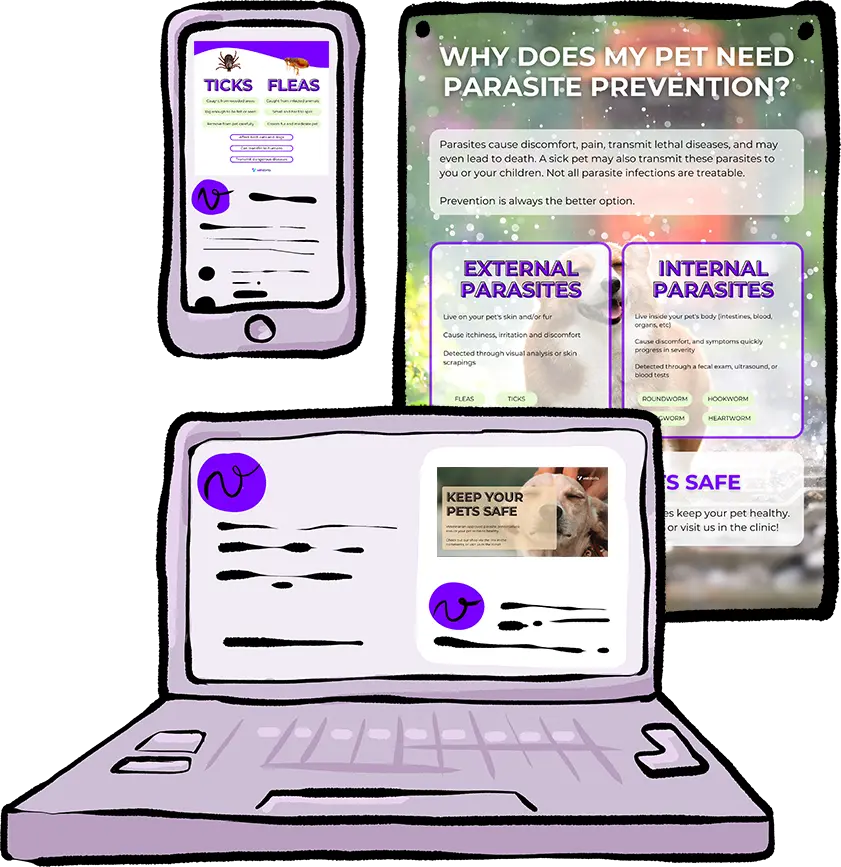Teach pet owners about Parasite Prevention
Prevention is the best medicine! Ensure pet owners are aware of the common internal and external parasites with our Parasite Prevention pack! To save you even more time, we’ve included a pre-written email, and suggested captions for each of our social media templates!
Download our ready-to-use social assets:
Or brand the content for your clinic in 3 easy steps

Choose the pack you want, and open the clickable template links

Export the design as it is, or add your logo, brand colors, and update the text

Download the design for your digital channels, or print physical copies!
Customize the assets as you like:
What information is included in the Pet Parasite pack?
External parasites, like fleas and ticks, live on the outside of your pet’s body. They may hide under your pet’s fur, or live in exposed areas, such as the ears or the paws.
- External parasites usually lead to irritation and pain, and are most dangerous to young or sick animals.
- External pet parasites can transmit more dangerous diseases.
- Remember that not all external pet parasites are visible with the naked eye, so the fact that you can’t see any doesn’t mean they’re not there!
Internal parasites live inside your pet’s body. Internal pet parasites may burrow under the skin, be ingested and live in your pet’s intestines, or can even be in their bloodstream!
- Some internal pet parasites can be deadly, while others cause discomfort and pain.
- Internal parasites can be quite difficult to detect, so if your pet is showing symptoms, it’s paramount that you get them checked by a veterinarian.
Ticks – Ticks are small, spider-like parasites that live in wooded areas. They climb onto your pet to drink their blood. Ticks can live anywhere on your pet’s body, but they tend to prefer the neck, ears, toes, and folds between the legs and the body. Ticks can infect humans too.
Fleas – Fleas are very small insects that survive by drinking blood. Pets usually contract fleas from infected pets or wild animals, but flea larvae and eggs can be found in sheltered outside areas.
Lice – Lice are very small bugs that drink the blood or eat the surface skin of your pets. Just like with humans, this causes itching and discomfort. Luckily, lice are species specific – meaning that your pets can’t transmit their lice to you, nor you to them.
Walking Dandruff – Cheyletiella are small parasitic mites that live on the surface of your pet’s skin. They cause flaking and scaling of the skin, and the small white mites can appear as moving specs of dandruff – hence their distinctive name.
Ear Mites – Mites are spider-like bugs that infest your pet’s ears, both on the surface and in the ear canal. They’re barely visible to the naked eye. They cause itching, scratching and ear discharge.
Ringworm – Despite the name, ringworm isn’t really a worm, it’s a fungus similar to athlete’s foot. It causes red scaly lesions on the surface of the skin, as well as fur loss in the affected area. Ringworm can be easily transmitted between humans and pets. Pets contract this disease through contact with infected animals, or with contaminated areas such as bedding or furniture. Pets can carry this disease without showing any clinical symptoms; young, elderly, or immunocompromised pets are more likely to get sick. In humans, children are most at risk.
Ticks – If you find a tick, it’s important to remove it as soon as possible. Ticks transmit dangerous diseases, and the longer they stay attached, the more likely your pet is to become infected. Don’t burn or hurt the tick, as this can increase the chance of infection. Instead, take a pair of tweezers, grab the tick by the head as close to your pet’s skin as possible, and gently pry them loose without twisting. Once removed, kill the tick while being careful not to touch its fluids.
Fleas – If your pet has fleas, groom your pet’s fur with a fine-toothed comb to get as many fleas off their fur as possible. You can kill the fleas by dunking the comb in hot soapy water (don’t try to crush them). Certain medications help kill fleas, or inhibit certain parts of their lifecycle. In addition to using anti-flea medication, ensure you clean your house thoroughly and constantly – flea eggs and larvae can survive on rugs, bedding, under the floorboards and furniture and reinfect your dog if they’re not removed.
Don’t forget to guarantee that your pet’s preventatives are up to date!
Lice – If your pet has lice, you’ll need to use a product to kill the adult parasites, you’ll need to groom your pet with a fine-toothed comb, and you’ll need to thoroughly clean your home. Lice eggs (called nits) continue to hatch in the environment for 2-3 weeks after they’ve been laid, so you need to continue treatment until all of them have been eliminated.
Walking Dandruff – Cheyletiella infection is becoming rarer, since most flea preventatives work well to repel and kill these mites. Your pet can become infected from direct contact with a sick animal, usually at shelters, groomers or breeders. Cheyletiella can infect humans, but it’s usually very mild.
Ear mites – If your pet is itching, shaking their head more than usual (especially if they do so so violently that they break blood vessels), they might have ear mites. You need to take them to the vet. Your veterinarian will examine the mites under the microscope to make a diagnosis, and prescribe treatment.
Ringworm – If your pet is showing patchy fur, circular areas of patchy and scaly skin, or brittle hair or claws, take them to a veterinarian. Use gloves while handling infected animals, and isolate them from other pets in the household. Diagnosis is done through a laboratory culture of the fungus, and treatment will usually include topical creams as well as oral antifungal medicine. Follow your vet’s instructions to complete the full course of treatment, and clean your living area thoroughly, or reinfection may occur.
Scabies – Scabies is a skin infection caused by microscopic mites that burrow into your pet’s skin. Scabies is highly infectious and affects humans too. Scabies lesions look like red scabs or rashes, and often cause hair loss in the affected area.
Roundworms – Roundworms, here referring to a family of animals called ascarids, are a type of parasitic worm that infects the host’s intestines. Infection doesn’t always lead to symptoms, but can be dangerous to young puppies and kittens. This parasite can reduce a pet’s appetite, and cause vomiting or diarrhea.
Lungworm – Lungworm larvae lives in the slime of slugs, snails, and sometimes frogs. Your pet might catch it from eating infected snails, or by coming into contact with their slime, such as in food bowls left outside. Contact with feces from other infected pets also transmits the disease. Cats can also catch lungworm from eating infected prey, such as mice or birds. The lungworm parasite that infects cats is different from the one that infects dogs, and neither transmit to humans (though it’s always important to exhibit caution when dealing with pet feces). Unlike other parasitic worms, the adults of these species don’t stay in the intestine -they travel around your pet’s body, causing damage to multiple organs, and usually settle in the chest around the lungs or heart.
Hookworms – Hookworms are a type of parasitic worm that lives in pets’ intestines. They can be contracted by ingesting infected soil or by grooming larvae off their skin. Worms can also pierce the skin to infect an unsuspecting pet. Hookworms can infect people this way, as well.
Scabies – Diagnosing scabies can be difficult. Because the mites burrow under the skin, they don’t always show up on tests. Your veterinarian will best guide you through the process of diagnosis and treatment. In addition to killing the parasite, treatment often includes soothing the skin to avoid complications and secondary infections.
Roundworms – Young puppies and kittens need routine deworming from a very young age. For older pets, routine deworming can usually deal with roundworm parasites. Talk to your veterinarian if symptoms persist, or if you notice adult roundworms in your pet’s vomit or feces.
Lungworm – You can mitigate the risk of infection by keeping your pet away from snails and slugs, animal feces, and food left outside. If you can, prevent your cat from hunting. If possible, do not leave food and water bowls outside; if you do, clean them thoroughly and often. Not all worming treatments work to prevent lungworm, so if your pet is at risk, ask your veterinarian for better options. If your pet is coughing, lethargic, has unexplained bruises and bleeding: take them to a veterinarian immediately.
Hookworm – Hookworm infection can cause blood loss and anemia, weakness and weight loss. Most routine dewormings can deal with this parasite, but if symptoms persist, contact your vet for advice.
- Use preventative medicine year-round! Yes, even indoor pets require year-round preventatives. Always make sure you use them according to package instructions or to your veterinarian’s advice.
- Keep your home and yard clean.
- Keep wild and feral animals away from your yard. Keep rubbish in bins, do not leave animal feed outside, and consider using repellents such as motion activated sprinklers.
- If your pet is vulnerable (sick, immunocompromised, or elderly), be conscious of areas where animals congregate, such as dog parks.
- If your pet shows symptoms, call your veterinarian for advice.
Did you know that fleas can jump up to 200 times their body size? Yikes.
Our Content Pack Calendar has all the marketing assets you need for the rest of the year neatly mapped onto a calendar. It’s been specially designed to help you have the most engaging, productive, and profitable quarter yet for your veterinary clinic. Download 2023 Q4 calendar here!

Get Vetstoria Content Packs direct to your Inbox
Vetstoria users get more, with online booking links and QR codes

Build online booking campaigns
Create promotional booking campaigns (like free dental check ups!) that follow set scheduling rules based on your preferred dates, the availability of vets, and more!

Add trackable booking links and QR codes
Use trackable links in emails, SMS, social profiles, online ads and in the clinic to promote your campaigns and easily measure the results.

Use analytics to optimize results
See how many appointments and new clients are generated from each campaign, and learn which channels are most effective.

Build online booking campaigns
Create promotional booking campaigns that follow set scheduling rules based on preferred dates, the availability of vets, and more!

Add booking links to digital channels
Use trackable booking links in emails, SMS, social profiles, and online ads to promote your campaigns and easily measure the results.

Use analytics to optimize results
See how many appointments and new clients are generated from each campaign, and learn which channels are most effective.


